Snow Avalanche Hazards and Avalanche-Prone Area Mapping in Tibet
Abstract
1. Introduction
2. Snow Avalanche Hazards
2.1. Overall Overview in Tibet
2.2. Avalanche Hazards in Southeastern Tibet and Himalayas
2.3. Avalanche Hazards Along Sichuan–-Tibet Highway Corridor
3. Materials and Methods
3.1. Study Area
3.2. Methods and Data
4. Snow Avalanche-Prone Area Mapping and Verification
4.1. Snow Cover
4.2. Snow Avalanche-Prone Area Mapping
4.3. Field Investigation and Verification
4.4. Snow Avalanche-Prone Areas in the Parlung Zangbo and Sangchu River Basins
5. Discussions
6. Limitations and Outlook
7. Conclusions and Recommendations
- (1)
- Nyainqentanglha Mountain and its southeastward extension in southeastern Tibet and the southern slope of the Himalaya Mountains are two regions with the highest frequency of avalanches in Tibet. Snow avalanche is one of most dangerous natural hazards to road traffic safety in mountainous areas of Tibet during snow seasons. Of those, the Anjula–Tongmai section of the Sichuan–Tibet highway and Galongla section of the Zhamo–Metok highway are the most affected areas by snow avalanche hazards in the spring and winter seasons.
- (2)
- A mapping method for avalanche-prone areas was proposed based on snow cover and DEM data and was verified using ground observations. Overall accuracy of mapping method reached 77.3%. The perennial snow avalanche-prone areas accounted for 1.6%, while snow avalanche-prone areas in winter and spring accounted for 2.9% and 4.9% of the total area, respectively.
- (3)
- In recent years, human activities, such as mountaineering and adventure tourism, have become more frequent in the high mountains, and casualties and economic losses caused by snow avalanches show an increasing trend. Therefore, in addition to the implementation of engineering prevention and control measures in the key areas, such as in the Sichuan–Tibet highway and railway sections, monitoring, early warning, and forecasting services and related scientific research should be strengthened on the basis of detailed investigation and avalanche hazard zoning.
- (4)
- Enhancing popular science education on hazard prevention and reduction among the public and raising their awareness of disaster prevention is essential to prevent and mitigate avalanche hazards for the long haul. It is particularly important to promote science education on prevention of snow and ice avalanche hazards for mountaineers and adventure tourists.
- (5)
- Apart from snow avalanches, snow cover on the roads is the main snow-related hazard currently that affects traffic in the high mountain regions in Tibet during the cold seasons. Therefore, the study also suggested that, in addition to implementing engineering measures such as snow nets, shed holes and tunnels in the pivotal roads, enhancing monitoring, forecasting, and early warning services is crucial to prevent and mitigate relevant hazards in the Tibetan high mountain regions in the future.
Author Contributions
Funding
Data Availability Statement
Acknowledgments
Conflicts of Interest
References
- Wester, P.; Mishra, A.; Mukherji, A.; Shrestha, A.B. (Eds.) The Hindu Kush Himalaya Assessment–Mountains, Climate Change, Sustainability and People; Springer Nature Switzerland AG: Cham, Switzerland, 2019; pp. 390–400. [Google Scholar]
- Jacquemart, M.; Weber, S.; Chiarle, M.; Chmiel, M.; Cicoira, A.; Corona, C.; Eckert, N.; Gaume, J.; Giacona, F.; Hirschberg, J.; et al. Detecting the impact of climate change on alpine mass movements in observational records from the European Alps. Earth Sci. Rev. 2024, 258, 104886. [Google Scholar] [CrossRef]
- Rafique, A.; Dasti, M.Y.S.; Ullah, B.; Awwad, F.A.; Ismail, E.A.A.; Saqib, Z.A. Snow avalanche hazard mapping using a GIS-based AHP approach: A case of glaciers in northern Pakistan from 2012 to 2022. Remote Sens. 2023, 15, 5375. [Google Scholar] [CrossRef]
- Varol, N. Avalanche susceptibility mapping with the use of frequency ratio, fuzzy and classical analytical hierarchy process for Uzungol area, Turkey. Cold Reg. Sci. Technol. 2021, 194, 103439. [Google Scholar] [CrossRef]
- Fischer, J.T. A novel approach to evaluate and compare computational snow avalanche simulation. Nat. Hazards Earth Syst. Sci. 2013, 13, 1655–1667. [Google Scholar] [CrossRef]
- Liu, Y.; Chen, X.; Qiu, Y.; Hao, J.; Yang, J.; Li, L. Mapping snow avalanche debris by object-based classification in mountainous regions from Sentinel-1 images and causative indices. Catena 2021, 206, 105559. [Google Scholar] [CrossRef]
- Giacona, F.; Eckert, N.; Corona, C.; Mainieri, R.; Morin, S.; Stoffel, M.; Martin, B.; Naaim, M. Upslope migration of snow avalanches in a warming climate. Proc. Natl. Acad. Sci. USA 2021, 118, e2107306118. [Google Scholar] [CrossRef]
- Eckert, N.; Corona, C.; Giacona, F.; Gaume, J.; Mayer, S.; Herwijnen, A.; Hagenmuller, P.; Stoffel, M. Climate change impacts on snow avalanche activity and related risks. Nat. Rev. Earth Environ. 2024, 5, 369–389. [Google Scholar] [CrossRef]
- Wastl, M.; Stötter, J.; Kleindienst, H. Avalanche risk assessment for mountain roads: A case study from Iceland. Nat. Hazards 2011, 56, 465–480. [Google Scholar] [CrossRef]
- Schweizer, J.; Mitterer, C.; Techel, F.; Stoffel, A.; Reuter, B. On the relation between avalanche occurrence and avalanche danger level. Cryosphere 2020, 14, 737–750. [Google Scholar] [CrossRef]
- Hao, J.; Zhang, X.; Cui, P.; Li, L.; Wang, Y.; Zhang, G.; Li, C. Impacts of climate change on snow avalanche activity along a transportation corridor in the Tianshan mountains. Int. J. Disaster Risk Sci. 2023, 14, 510–522. [Google Scholar] [CrossRef]
- Evans, S.G.; Bishop, N.F.; Smoll, L.F.; Murillo, P.V.; Delaney, K.B.; Smith, A.O. A re-examination of the mechanism and human impact of catastrophic mass flows originating on Nevado Huascarán, Cordillera Blanca, Peru in 1962 and 1970. Eng. Geol. 2009, 108, 96–118. [Google Scholar] [CrossRef]
- Stethem, C.; Jamieson, B.; Schaerer, P.; Liverman, D.; Germain, D.; Walker, S. Snow avalanche hazard in Canada—A review. Nat. Hazards 2003, 28, 487–515. [Google Scholar] [CrossRef]
- Thakuri, S.; Chauhan, R.; Baskota, P. Glacial hazards and avalanches in high mountains of Nepal Himalaya. J. Tour. Himal. Adventures 2020, 2, 87–104. [Google Scholar]
- McClung, D.M. Avalanche character and fatalities in the high mountains of Asia. Ann. Glaciol. 2016, 57, 114–118. [Google Scholar] [CrossRef]
- Glazovskaya, T.G. Global distribution of snow avalanches and changing activity in the Northern Hemisphere due to climate change. Ann. Glaciol. 1998, 26, 337–342. [Google Scholar] [CrossRef]
- Hafner, E.D.; Barton, P.; Daudt, R.C.; Wegner, J.D.; Schindler, K.; Bühler, Y. Automated avalanche mapping from SPOT 6/7 satellite imagery with deep learning: Results, evaluation, potential and limitations. Cryosphere 2022, 16, 3517–3530. [Google Scholar] [CrossRef]
- Bühler, Y.; Hüni, A.; Christen, M.; Meister, R.; Kellenberger, T. Automated detection and mapping of avalanche deposits using airborne optical remote sensing data. Cold Reg. Sci. Technol. 2009, 57, 99–106. [Google Scholar]
- Hao, J.; Mind’je, R.; Zhang, X.; Wang, Y.; Zhou, H.; Li, L. Implementation of an early warning for snowfall-triggered avalanche to road safety in the Tianshan Mountains. Cold Reg. Sci. Technol. 2022, 204, 103675. [Google Scholar] [CrossRef]
- Strapazzon, G.; Schweizer, J.; Chiambretti, I.; Maeder, M.B.; Brugger, H.; Zafren, K. Effects of climate change on avalanche accidents and survival. Front. Physiol. 2021, 12, 639433. [Google Scholar] [CrossRef]
- Hafner, E.D.; Techel, F.; Leinss, S.; Bühler, Y. Mapping avalanches with satellites-evaluation of performance and completeness. Cryosphere 2021, 15, 983–1004. [Google Scholar] [CrossRef]
- Bühler, Y.; Bebi, P.; Christen, M.; Margreth, S.; Stoffel, L.; Stoffel, A.; Marty, C.; Schmucki, G.; Caviezel, A.; Kühne, R.; et al. Automated avalanche hazard indication mapping on a statewide scale. Nat. Hazards Earth Syst. Sci. 2022, 22, 1825–1843. [Google Scholar] [CrossRef]
- Bühler, Y.; Hafner, E.D.; Zweifel, B.; Zesiger, M.; Heisig, H. Where are the avalanches? Rapid SPOT6 satellite data acquisition to map an extreme avalanche period over the Swiss Alps. Cryosphere 2019, 13, 3225–3238. [Google Scholar] [CrossRef]
- Eckerstorfer, M.; Bühler, Y.; Frauenfelder, R.; Malnes, E. Remote sensing of snow avalanches: Recent advances, potential, and limitations. Cold Reg. Sci. Technol. 2016, 121, 126–140. [Google Scholar] [CrossRef]
- Eckerstorfer, M.; Vickers, H.; Malnes, E.; Grahn, J. Near-real time automatic snow avalanche activity monitoring system using Sentinel-1 SAR data in Norway. Remote Sens. 2019, 11, 2863. [Google Scholar] [CrossRef]
- Eckerstorfer, M.; Christiansen, H.H. Topographical and meteorological control on snow avalanching in the Longyearbyen area, Central Svalbard 2006–2009. Geomorphology 2011, 134, 186–196. [Google Scholar] [CrossRef]
- Eckerstorfer, M.; Oterhals, H.D.; Müller, K.; Malnes, E.; Grahn, J.; Langeland, S.; Velsand, P. Performance of manual and automatic detection of dry snow avalanches in Sentinel-1 SAR images. Cold Reg. Sci. Technol. 2022, 198, 103549. [Google Scholar] [CrossRef]
- Cui, P.; Jia, Y. Mountain hazards in the Tibetan Plateau: Research status and prospects. Natl. Sci. Rev. 2015, 2, 397–399. [Google Scholar] [CrossRef]
- Wang, Y. Snow Avalanche Study in China; China Ocean Press: Beijing, China, 1992. (In Chinese) [Google Scholar]
- Institute of Mountain Hazards and Environment of CAS. Study on Typical Mountain Hazards Along the Sichuan-Tibet Highway; Chengdu University of Science and Technology Press: Chengdu, China, 1999. (In Chinese) [Google Scholar]
- Yang, Y. Mountain hazards in Tangmai natural barrier along the Sichuan-Xizang(Tibet) highway and its controls. Mt. Res. 1997, 15, 288–292. (In Chinese) [Google Scholar]
- Yang, Z.; Shang, Y.; Zhang, L.; Xu, B. Study on Geohazards and Prevention and Control Measures in the Sichuan-Tibet Highway; Science Press: Beijing, China, 2006. (In Chinese) [Google Scholar]
- Chen, C.; Yu, S.; Wang, L.; Zhang, X. The quantitative analysis of snow avalanches with remote sensing and engineering scheme selection. J. Mt. Sci. 2009, 27, 63–69. (In Chinese) [Google Scholar]
- Zhao, X.; Cheng, Z.; Li, Y.; Yang, T.; Qiang, B. Avalanche distribution analysis in Anjula Mountain to Guxiang section of Sichuan-Tibet highway. Mt. Res. 2015, 33, 480–487. (In Chinese) [Google Scholar]
- Wen, H.; Wu, X.; Liao, X.; Wang, D.; Huang, K.; Wünnemann, B. Application of machine learning methods for snow avalanche susceptibility mapping in the Parlung Tsangpo catchment, southeastern Qinghai-Tibet Plateau. Cold Reg. Sci. Technol. 2022, 198, 103535. [Google Scholar] [CrossRef]
- Cui, P.; Ge, Y.; Li, S.; Li, Z.; Xu, X.; Zhou, G.G.; Chen, H.; Wang, H.; Lei, Y.; Zhou, L.; et al. Scientific challenges in disaster risk reduction for the Sichuan–Tibet Railway. Eng. Geol. 2022, 309, 106837. [Google Scholar] [CrossRef]
- Tibet Meteorological Bureau and Institute of Mountain Hazards and Environment of CAS. Snow and Ice Hazard Prevention Plan in Tibet Autonomous Region; 2020; Unpublished work. [Google Scholar]
- Tian, L.; Yao, T.; Gao, Y.; Thompson, L.; Thompson, E.M.; Muhammad, S.; Zong, J.; Wang, C.; Jin, S.; Li, Z. Two glaciers collapse in western Tibet. J. Glaciol. 2017, 63, 194–197. [Google Scholar] [CrossRef]
- Kääb, A.; Leinss, S.; Gilbert, A.; Bühler, Y.; Gascoin, S.; Evans, S.G.; Bartelt, P.; Berthier, E.; Brun, F.; Chao, W.; et al. Massive collapse of two glaciers in western Tibet in 2016 after surge-like instability. Nat. Geosci. 2018, 11, 114–120. [Google Scholar] [CrossRef]
- Deng, Y. Snow avalanche in Guxiang region of Xizang and its role in the physical geographic processes of high mountains. Acta Geog. Sin. 1980, 35, 242–250. (In Chinese) [Google Scholar]
- Li, J.; Zheng, B.; Yang, X. Glaciers in Tibet; Science Press: Beijing, China, 1986. (In Chinese) [Google Scholar]
- Chu, D.; Liu, L.; Wang, Z. Spatial distribution of snow cover in Tibet and topographic dependence. Atmosphere 2023, 14, 1284. [Google Scholar] [CrossRef]
- Chu, D. Remote Sensing of Land Use and Land Cover in Mountain Region; Springer Nature: Singapore, 2020. [Google Scholar]
- Maggioni, M.; Gruber, U. The influence of topographic parameters on avalanche release dimension and frequency. Cold Reg. Sci. Technol. 2003, 37, 407–419. [Google Scholar] [CrossRef]
- Barbolini, M.; Pagliardi, M.; Ferro, F.; Corradeghini, P. Avalanche hazard mapping over large undocumented areas. Nat. Hazards 2011, 56, 451–464. [Google Scholar] [CrossRef]
- Wen, H.; Wu, X.; Shu, X.; Wang, D.; Zhao, S.; Zhou, G.; Li, X. Spatial heterogeneity and temporal tendency of channeled snow avalanche activity retrieved from Landsat images in the maritime snow climate of the Parlung Tsangpo catchment, southeastern Tibet. Cold Reg. Sci. Technol. 2024, 223, 104206. [Google Scholar] [CrossRef]
- McClung, D.M.; Schaerer, P. The Avalanche Handbook, 3rd ed.; The Mountaineers Books: Seattle, WA, USA, 2006. [Google Scholar]
- Schweizer, J.; Jamieson, B.J.; Schneebeli, M. Snow avalanche formation. Rev. Geophys. 2003, 41, 1016. [Google Scholar] [CrossRef]
- Wei, Y.; Yang, H.; Han, X. Method for avalanche risk evaluation along Qinghai-Tibet Plateau railway. China Safety Sci. J. 2004, 14, 40–42. (In Chinese) [Google Scholar]
- Ma, D.; Cui, P.; Wang, Z. An approach on snow hazards and their countermeasures along Sino-Nepalese highway. J. Mt. Sci. 2002, 20, 59–63. (In Chinese) [Google Scholar]
- Chu, D.; Liu, L.; Wang, Z. Snow cover on the Tibetan Plateau and topographic controls. Remote Sens. 2023, 15, 4044. [Google Scholar] [CrossRef]
- Ballesteros-Cánovas, J.A.; Trappmann, D.; Madrigal-González, J.; Eckert, N.; Stoffel, M. Climate warming enhances snow avalanche risk in the Western Himalayas. Proc. Natl. Acad. Sci. USA 2018, 115, 3410–3415. [Google Scholar] [CrossRef] [PubMed]
- Mukherji, A.; Sinisalo, A.; Nüsser, M.; Garrard, R.; Eriksson, M. Contributions of the cryosphere to mountain communities in the Hindu Kush Himalaya: A review. Reg. Environ. Chang. 2019, 19, 1311–1326. [Google Scholar] [CrossRef]



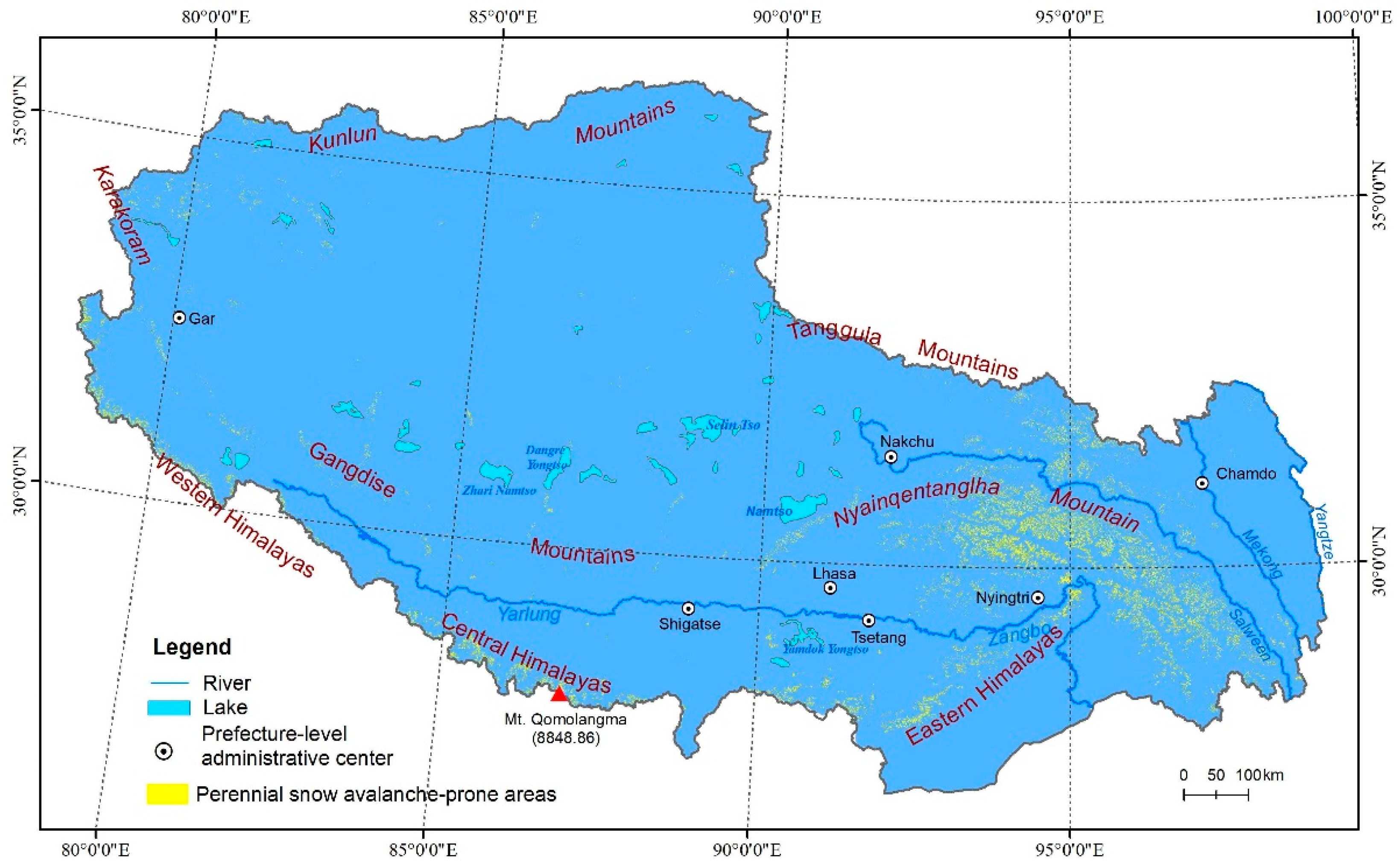
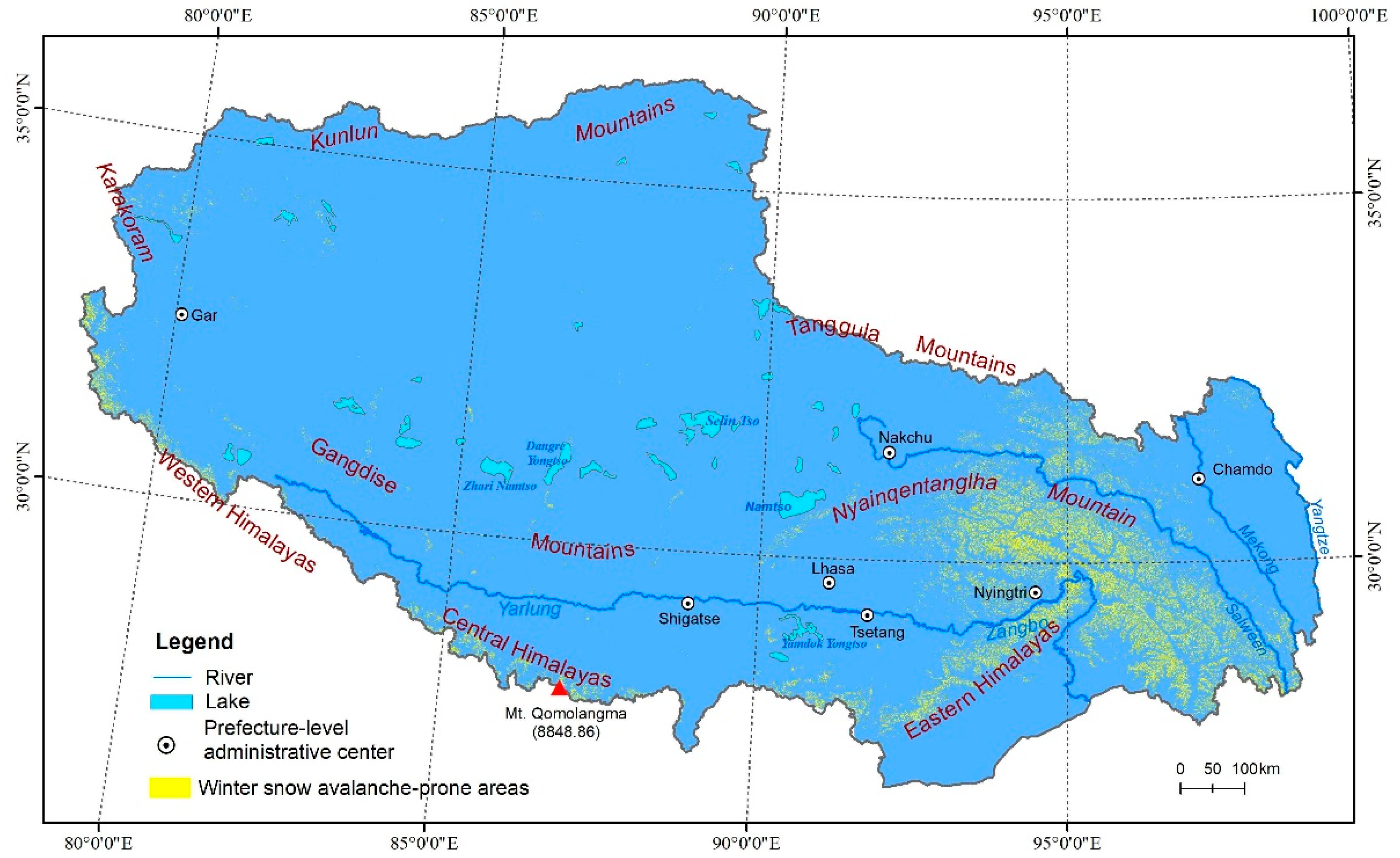

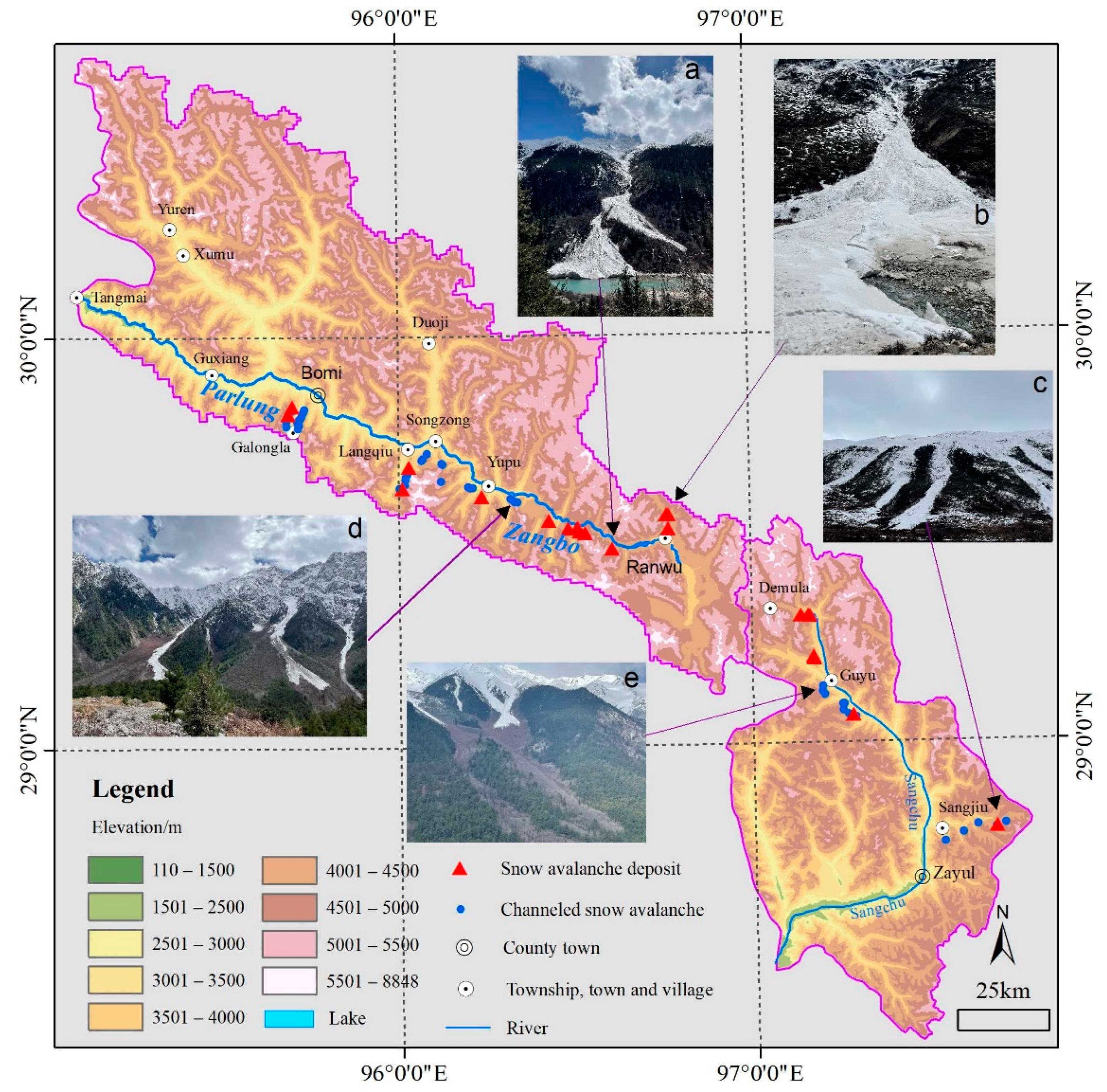
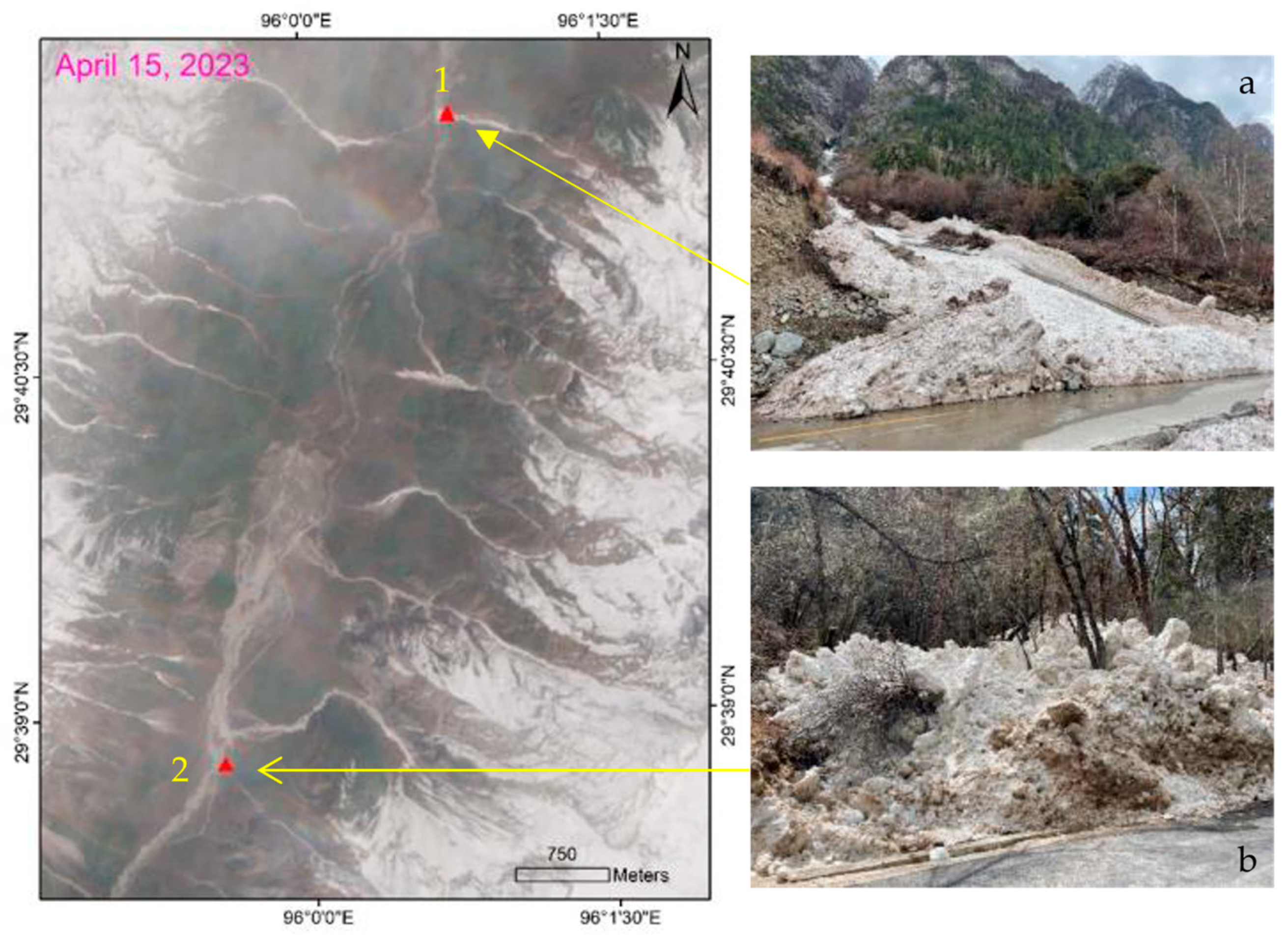
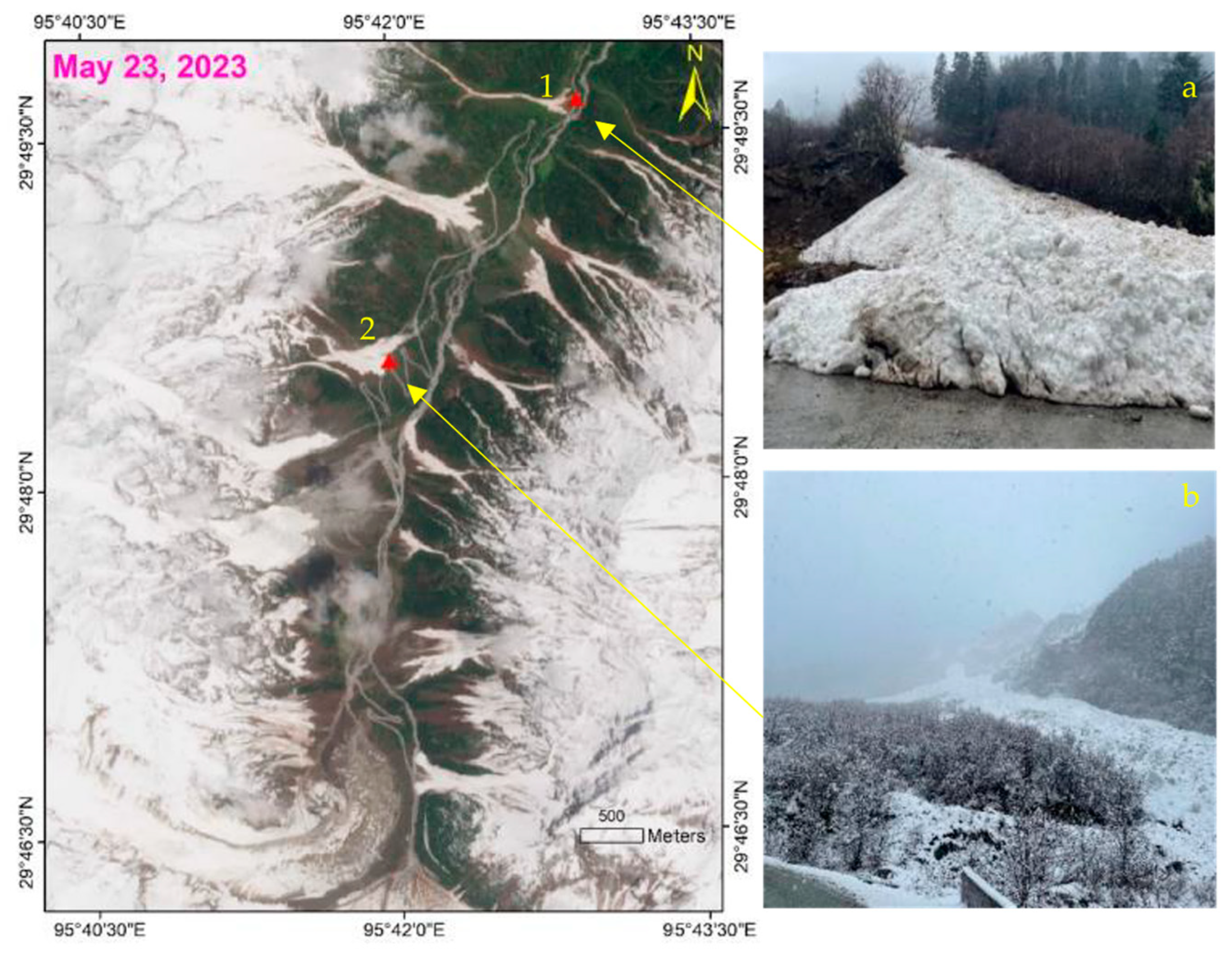
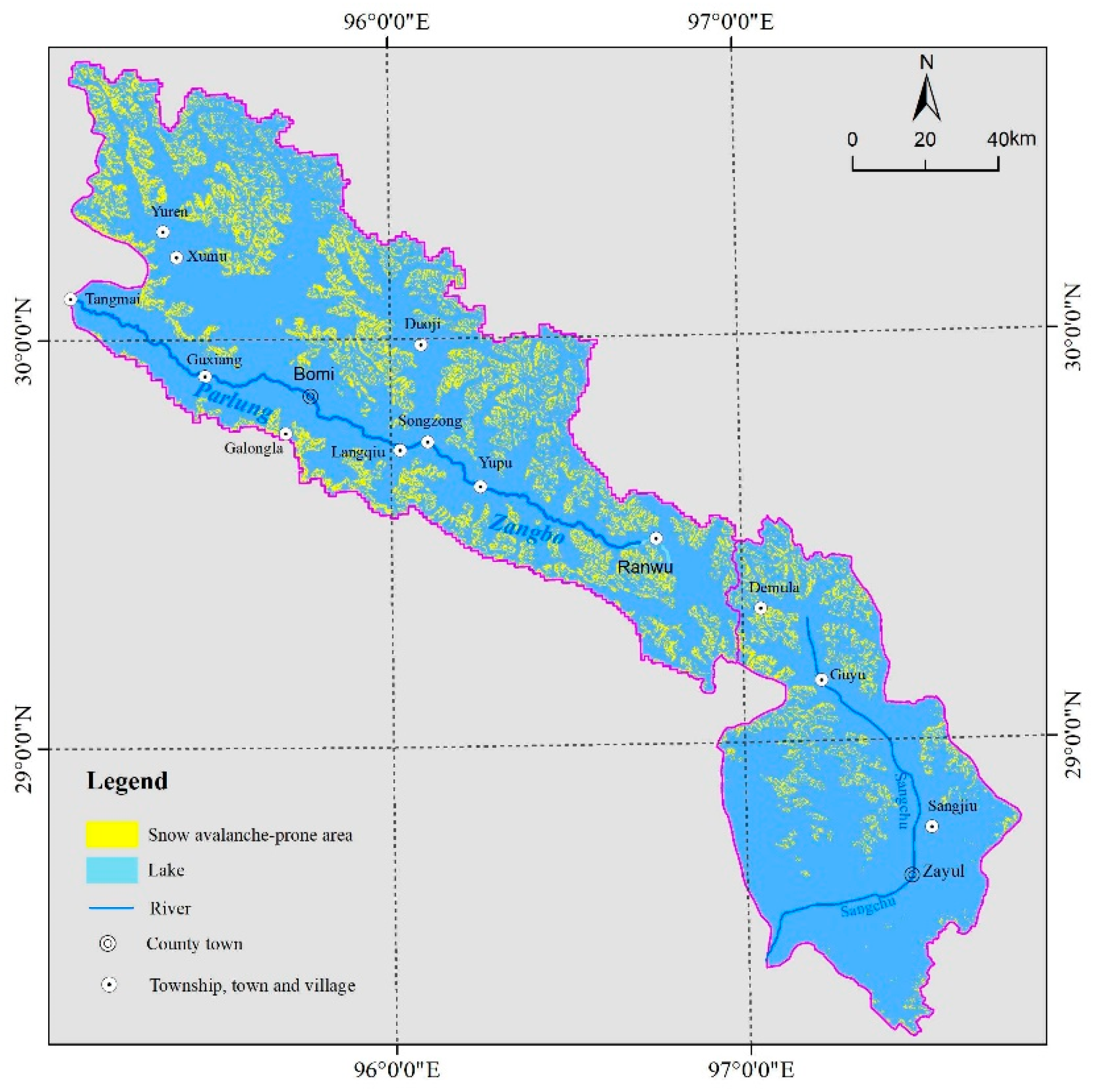


Disclaimer/Publisher’s Note: The statements, opinions and data contained in all publications are solely those of the individual author(s) and contributor(s) and not of MDPI and/or the editor(s). MDPI and/or the editor(s) disclaim responsibility for any injury to people or property resulting from any ideas, methods, instructions or products referred to in the content. |
© 2024 by the authors. Licensee MDPI, Basel, Switzerland. This article is an open access article distributed under the terms and conditions of the Creative Commons Attribution (CC BY) license (https://creativecommons.org/licenses/by/4.0/).
Share and Cite
Chu, D.; Liu, L.; Wang, Z.; Nie, Y.; Zhang, Y. Snow Avalanche Hazards and Avalanche-Prone Area Mapping in Tibet. Geosciences 2024, 14, 353. https://doi.org/10.3390/geosciences14120353
Chu D, Liu L, Wang Z, Nie Y, Zhang Y. Snow Avalanche Hazards and Avalanche-Prone Area Mapping in Tibet. Geosciences. 2024; 14(12):353. https://doi.org/10.3390/geosciences14120353
Chicago/Turabian StyleChu, Duo, Linshan Liu, Zhaofeng Wang, Yong Nie, and Yili Zhang. 2024. "Snow Avalanche Hazards and Avalanche-Prone Area Mapping in Tibet" Geosciences 14, no. 12: 353. https://doi.org/10.3390/geosciences14120353
APA StyleChu, D., Liu, L., Wang, Z., Nie, Y., & Zhang, Y. (2024). Snow Avalanche Hazards and Avalanche-Prone Area Mapping in Tibet. Geosciences, 14(12), 353. https://doi.org/10.3390/geosciences14120353






